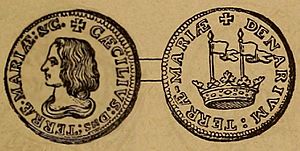Lord Baltimore penny facts for kids
| Years of minting | 1659 |
|---|---|
| Obverse | |
 |
|
| Reverse | |
The Lord Baltimore penny is the first copper coin circulated in America. It, along with three silver coins, were made as a set specifically for Cecil Calvert, 2nd Baron Baltimore. They were made for the Province of Maryland to be circulated in the Thirteen Colonies.
History
The Lord Baltimore penny is one of a series of four portrait coins ordered and made specifically for Cecil Calvert, 2nd Baron Baltimore (also known as "Lord Baltimore") for circulation in the province of Maryland and has his portrait image on it. It is sometimes referred to as the Maryland penny. It is the first copper coin circulated in the American Thirteen Colonies. The designer of the dies for this special set of coins ordered by Lord Baltimore was Nicholas Briot. On October 12, 1659, Briot sent samples of the coins made in London to the secretary for Maryland, Philip Calvert, brother of Lord Baltimore. A letter from Briot came with the coin samples of a shilling, sixpence, groat and penny. Briot indicated he could make the necessary coins in London and then would sell them to the Maryland colonists. The letter suggested that the coins be promoted in the Province of Maryland for circulation as the usage of its money. Lord Baltimore then put this idea to the colonists for official adoption. At that time, between the time of the death of Cromwell in September 1658 and Philip Calvert becoming governor of Maryland, there was nothing done with the coinage.
Philip Calvert became governor of Maryland in November 1660. He instigated and promoted the idea for a mint. On May 1, 1661, the Maryland Assembly passed an act to establish a mint in the colony. The act defined the exact coinage to be made and the value as related to the current coinage in use in England. An official Maryland mint never came about since an English council determined that this was beyond the original rights given in the charter of Maryland. The idea of a mint was dropped at that time, however Lord Baltimore had large supplies of various silver coins made for him in London and shipped to the colonists. He was paid for these coins in tobacco. It is not known how many of these silver coins were actually used in Maryland.
The copper penny coin is very rare and only two are known to exist. The first one was found in England in 1819. The first printed mention of the piece is when it was sold to Englishman William Dinedale from a coin collection held by James Bindley, another Englishman. The coin collection was later sold in 1824 to Rev. Joseph Martin of Kent, England. The collection went from there to Londoner William Webster who bought the collection in 1859. It later was obtained by Joseph J. Mickley from Philadelphia. Michley's Lord Baltimore's copper penny went to a Mr. Stevens in 1867 for US $370. Stevens was an agent representing New York coin collector Charles I. Bushmell. Bushmell's collection was sold to Mr. Bock, a Philadelphia coin collector, in 1890 for US $550. Bock later turned his entire coin collection over to the University of Pennsylvania. The second Lord Baltimore copper penny was found by B.H. Collins, a well-known Washington D.C. coin collector, in a pile of old worn copper coins. This second specimen was bought also by Mr. Bock and it came with a set of English silver coins of shilling, sixpence, and groat made specifically for Lord Baltimore.
Lord Baltimore coins
The Lord Baltimore coin set consisted of four coins, three silver types and one copper type. On the obverse (front) of the coins is a bust of Lord Baltimore looking left. The 1659 coins were from England for an experiment of circulation. There is writing around the front Lord Baltimore image of these coins that reads "Caecilius, Dns: Terrae-Mariae" (Cecil Lord of Mary's Land).
On the back side of the silver coins is an escutcheon with the Baltimore arms (lozenge shield with a coronet on top). Lord Baltimore's shilling silver coin has the Roman numerals "XII" to the right and left. The sixpence silver coin has "VI" and the groat silver coin has a "IV" to indicate fourpence. The shilling is 0.925 pure silver and weighs 66 grains. The Maryland sixpence silver coin is the same quality and weighs 34 grains. The shilling and sixpence are just under an inch in diameter. The Maryland groat silver coin came in two varieties with a small and large portrait and shield. It weighs 25 grains and is about a half inch in diameter.
The Lord Baltimore penny copper coin was similar to the silver coins with the main difference being the back side. The reverse side of the copper penny is a duke's coronet crown with two pennons flying in the center and the writing around this image of "Denarium Terrae-Mariae" (Denarius of Mary’s land). The diameter is about 13/16th of an inch, which is a size between that of the Lord Baltimore groat and sixpence coins, and it weighs 57.5 grains.


